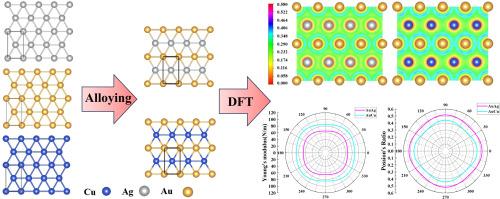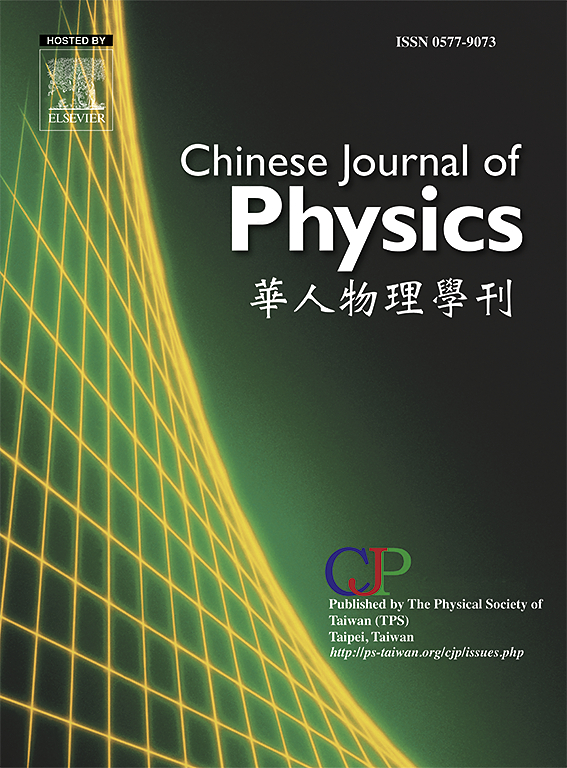Stability and physical property modulation in Ag/Cu-alloyed Au monolayers with triangular lattices: A first-principles investigation
IF 4.6
2区 物理与天体物理
Q1 PHYSICS, MULTIDISCIPLINARY
引用次数: 0
Abstract
Comprehensive first-principles calculations were performed to investigate how Ag and Cu alloying modulates the structural, energetic, and electronic properties of two-dimensional Au monolayers, resulting in the formation of AuAg and AuCu alloys. Both alloyed systems are thermodynamically stable and adopt an isosceles triangular lattice structure. The bond lengths in the alloyed monolayers generally fall between those of their elemental counterparts, with AuCu exhibiting notably shorter Au–Cu bonds, reflecting stronger atomic interactions.
Importantly, the binding energy of the AuCu monolayer is more negative than that of both pure Au and pure Cu monolayers, indicating enhanced stability due to cooperative bonding effects and orbital hybridization. Ab initio molecular dynamics (AIMD) simulations confirm thermal stability up to ∼1000 K, beyond which structural degradation occurs. Phonon dispersion calculations reveal no imaginary frequencies, supporting the dynamic stability of both alloyed systems.
Electronic band structure and density of states (DOS) analyses confirm their metallic character, with stronger hybridization observed in AuCu due to its reduced bond length and compact structure. Mechanical property evaluations—including elastic constants, Young’s modulus, and Poisson’s ratio—demonstrate that alloying leads to a reduction in stiffness and an increase in anisotropy. These findings highlight the tunability of 2D noble metal monolayers via alloying, offering promising avenues for future applications in flexible electronics, catalysis, and nanoscale devices.

三角形晶格银/铜合金金单分子层的稳定性和物理性质调制:第一性原理研究
通过综合第一性原理计算,研究了Ag和Cu合金化如何调节二维Au单层的结构、能量和电子性能,从而形成AuAg和AuCu合金。两种合金体系均具有热力学稳定性,均采用等腰三角形晶格结构。合金单层的键长通常介于元素层之间,其中AuCu的Au-Cu键明显较短,反映出更强的原子相互作用。重要的是,与纯Au和纯Cu单层相比,AuCu单层的结合能更负,表明由于协同键效应和轨道杂化,稳定性增强。从头算分子动力学(AIMD)模拟证实了高达~ 1000 K的热稳定性,超过该温度会发生结构降解。声子色散计算显示没有虚频率,支持两种合金系统的动态稳定性。电子能带结构和态密度(DOS)分析证实了它们的金属性质,由于其键长缩短和结构紧凑,在AuCu中观察到更强的杂化。力学性能评估——包括弹性常数、杨氏模量和泊松比——表明合金化导致刚度降低和各向异性增加。这些发现强调了二维贵金属单层通过合金化的可调性,为未来在柔性电子、催化和纳米级器件中的应用提供了有希望的途径。
本文章由计算机程序翻译,如有差异,请以英文原文为准。
求助全文
约1分钟内获得全文
求助全文
来源期刊

Chinese Journal of Physics
物理-物理:综合
CiteScore
8.50
自引率
10.00%
发文量
361
审稿时长
44 days
期刊介绍:
The Chinese Journal of Physics publishes important advances in various branches in physics, including statistical and biophysical physics, condensed matter physics, atomic/molecular physics, optics, particle physics and nuclear physics.
The editors welcome manuscripts on:
-General Physics: Statistical and Quantum Mechanics, etc.-
Gravitation and Astrophysics-
Elementary Particles and Fields-
Nuclear Physics-
Atomic, Molecular, and Optical Physics-
Quantum Information and Quantum Computation-
Fluid Dynamics, Nonlinear Dynamics, Chaos, and Complex Networks-
Plasma and Beam Physics-
Condensed Matter: Structure, etc.-
Condensed Matter: Electronic Properties, etc.-
Polymer, Soft Matter, Biological, and Interdisciplinary Physics.
CJP publishes regular research papers, feature articles and review papers.
 求助内容:
求助内容: 应助结果提醒方式:
应助结果提醒方式:


